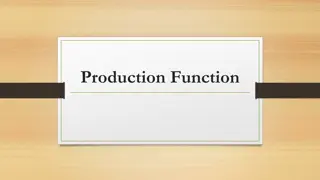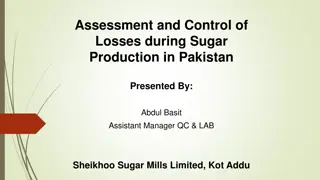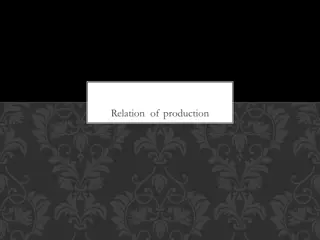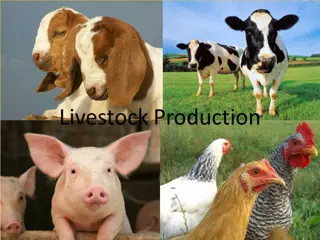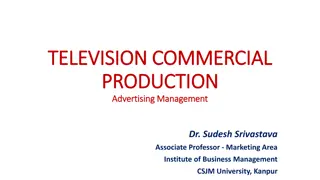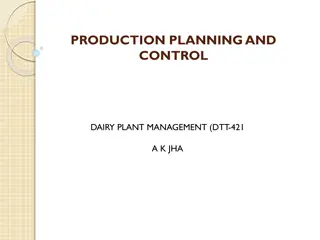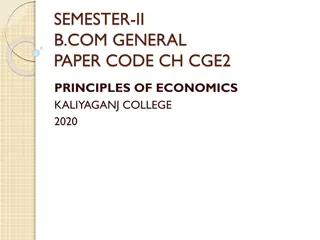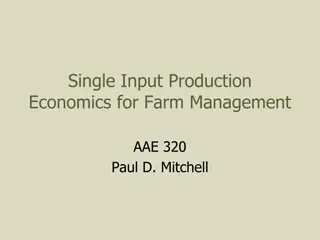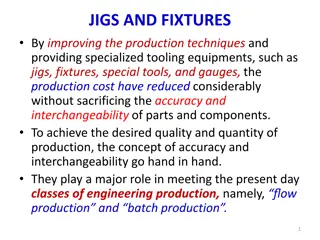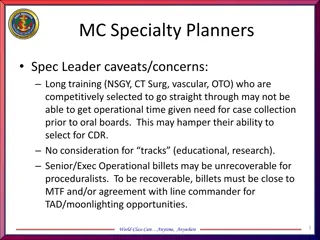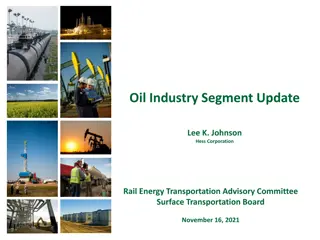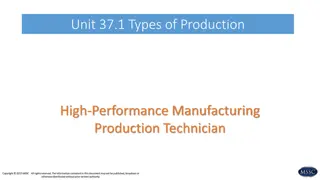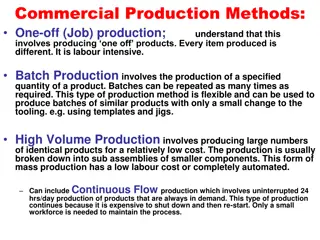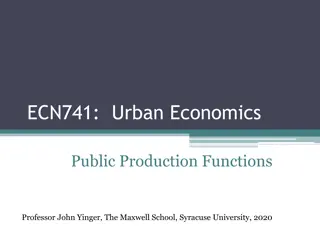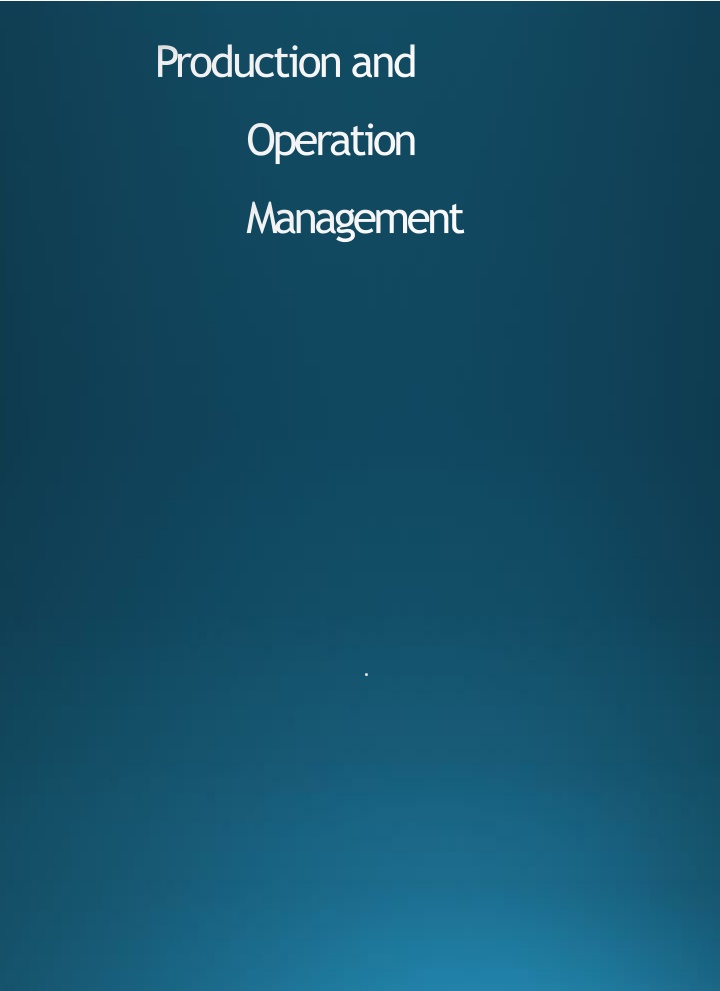
Boosting Productivity in Operations Management
Enhance productivity in production and operations management by understanding the significance of productivity, measuring it effectively, and implementing corrective actions for continuous improvement. Learn how to optimize resources and transform them into valuable products/services efficiently.
Download Presentation

Please find below an Image/Link to download the presentation.
The content on the website is provided AS IS for your information and personal use only. It may not be sold, licensed, or shared on other websites without obtaining consent from the author. If you encounter any issues during the download, it is possible that the publisher has removed the file from their server.
You are allowed to download the files provided on this website for personal or commercial use, subject to the condition that they are used lawfully. All files are the property of their respective owners.
The content on the website is provided AS IS for your information and personal use only. It may not be sold, licensed, or shared on other websites without obtaining consent from the author.
E N D
Presentation Transcript
Production and Operation Management .
CHAPTER-I PRODUCTIVITY 1.1 Introduction Production/Operation management is the process which combines and transforms various resources used in the production/operation subsystem of the organization into value added products/services in a controlled manner as per the policies of the organization. Value added products/services Resources used in production/ operation subsystem Transform (In controlled manner as per the policies of the organization) Production/Operation function: Range of inputs Required output (product/service) (Having the requisite quality level) The set of interrelated management activities which are involved in manufacturing certain products is called production management and for service management, then corresponding set of management activities is called as operation management. Examples: (Products/goods) Boiler with a specific capacity, Constructing flats, Car, bus, radio, television. Examples: (Services) Medical facilities, Travel booking services. In the process of managing various subsystems of the organization executives at different levels of the organization need to track several management decisions. The management decisions are Strategic, tactical and operational. Strategic (Top level) Tactical (Middle level) Operational (Bottom level) effective and efficientutilization of resources Plant location new product establishment Monitoring ofbudgets Defining goals Makingpolicies
Corrections from feedback information: Tight quality check on the incoming raw-material. Adjustment of machine settings. Change of tools. Proper allocation of operations to machines with matching skills. Change in the production plans. 2. Productivity: Productivity is a relationship between the output (product/service) and input (resources consumed in providing them) of a business system. The ratio of aggregate output to the aggregate input is called productivity. Productivity = output/Input For survival of any organization, this productivity ratio must be at least 1.If it is more than 1, the organization is in a comfortable position. The ratio of output produced to the input resources utilized in the production. 3. Importance: Benefits derived from higher productivity are as follows: It helps to cut down cost per unit and thereby improve the profits. Gains from productivity can be transferred to the consumers in form of lower priced Products or better quality products. These gains can also be shared with workers or employees by paying them at higher rate. A more productive entrepreneur can have better chances to exploit expert opportunities. It would generate more employment opportunity. Overall productivity reflects the efficiency of production system. More output is produced with same or less input. The same output is produced with lesser input. More output is produced with more input. The proportional increase in output being more than the proportional increase in input. 1.4 Productivity Measurement: Productivity may be measured either on aggregate basis or on individual basis, which are called total and partial measure. Total productivity Index/measure = Total output/ Total input = Total production of goods and services Labour+material+capital+Energy+management Partial productivity indices, depending upon factors used, it measures the efficiency of individual factor of production. 2
Labour productivity Index/Measure = Output in unit Man hours worked Management productivity Index/Measure = Output Total cost of management Machine productivity Index/Measure = Total output Machine hoursworked Land productivity Index/Measure = Total output Area of Landused Partial Measure = Output or Output Capital or Output or Output Materials Labour Energy PROBLEMS: Example-1 The input and output data for an industry given in the table. Find out various productivity measures like total, multifactor and partial measure. Output and Input production data in dollar ($) Output 1. Finished units 2. Work in progress 3. Dividends 4. Bonds 5. Other income 10,000 2,500 1,000 ------- -------- Input 1. Human 2. Material 3. Capital 4. Energy 5. Other Expenses Solution: Total measure = 3,000 153 10,000 540 1,500 Total Output = 13,500 =0.89 Total Input 15,193 Multi factor measure = Total Output = 13,500 = 4.28 Human+Material Multi factor measure = Finished units = 10,000 = 3.17 Human+Material Partial Measure1 = Total Output = 13,500 =25 Energy Partial Measure2= Finished units = 10,000 = 18.52 Energy 3,153 3,153 540 540 3
Note: For multifactor and partial measures it is not necessary to use total output as numerator. Often, it is describe to create measures that represent productivity as it relates to some particular output of interest. Other fields for the measurement of partial measures of productivity are: Business Restaurant Retail Store Utilityplant Paper mill Productivity Measure Customers (Meals) per labour hour Sales per square foot Kilowatts per ton of coal Tons of paper per cord of wood Example-2 A furniture manufacturing company has provided the following data. Compare the labour, raw materials and supplies and total productivity of 1996 and 1997. Output: Sales value of production in dollar ($) 22,000 (in 1996) and 35,000 (in 1997) 1996 10,000 8,000 1997 15,000 12,500 1,200 4,800 Inputs:Labour Raw materials and Supplies Capital equipment depreciation Other 700 2,200 Solution: 1996 1997 a. Partial productivities Labour Raw materials and Supplies b. Total Productivity 2.20 2.75 1.05 2.33 2.80 1.04 1.5 Productivity measurement approaches at the enterprises level: As stated above total productivity is expressed as the ratio of aggregate output to the aggregate input. That the total overall performance is captured in this ratio, becomes apparent, if we examine the relationship between this ratio and the age-old performance measure of profit. If the outputs and input for the period for which productivity is measured, are expressed in rupees, then under such restrictive assumptions one can write: Aggregate output =Gross Sales=G (Say) Aggregate input=Cost =C (Say) 4
Total Productivity=P(Say)=G ..(1) C From the definition of profit, we have; Profit= = G-C .(2) By dividing eqn (2) by C, =G 1 C C =P-1 C So from (1), For Zero profit ( =0), P = 1 For a Loss, ( 0),P 1 For a profit, 0,P 1 Zero profit will give a productivity value of 1, while a loss will give productivity value less than 1.The profit to cost ratio will determine the increase in productivity. The above relationship that demonstrates that increased profit to cost ratio will lead to increased overall productivity, is constituent with our expectation on how an overall performance measure should behave. However it suffers from a number of drawbacks. Some of which are listed here, a) Given that our objective in productivity measurement is to capture the efficiency of utilization of resources, the effect of price variations over time need to be corrected. Thus aggregate output should be equal to gross sales suitably inflated or deflated with respect to a base year. b) Equating output to sales implies, whatever is produced in the particular period is sold. Possibility of inventory, material manufactured for own use, etc. are n t taken in to consideration. c) Equating aggregate input to cost raises a host of problems and involves several restrictive assumptions. How to account for the fixed investment and working capital, whether to take the fringe benefits in to account etc. are some of the problems. The different approaches to measurement have arisen mainly in the context of correcting the above drawbacks. 1.6 Techniques for Productivity Improvement: Higher productivity in organization leads to national prosperity and better standard of living for the whole community. The methods contribute to the improvement of productivity are method study and work measurement by reducing work content and Ineffective time. 5
Work content means the amount of work contained in a given product or process measured in man-hour or machine-hour. Except in some cases like in processing industries, actual operation times are far in excess of the theoretical minimum. Ineffective time is the time for which the worker or machine or both are idle due to the shortcomings of the management or the worker. 6
CHAPTER-II PRODUCTION SYSTEM 2.1 Introduction A Production System is a system whose function is to transform an input into a desired output by means of a process (the production process) and of resources. The definition of a production system is thus based on four main elements: the input, the resources, the production process and the output. Resources Input-Production Process-Output Most of the organizations (including non-profit organization) can be described as production systems.These organizations transform (or convert) a set of inputs (such as materials, labour, equipment, energy etc.) in to one or useful outputs. The outputs of a production system are normally called products. These products may be: (a)Tangible goods (Steels,chemicalsetc.) (Teaching,health care etc.) (b)Intangible services (c)combination of (a) and (b) (fast food,tailoring etc.) INPUT Material Machines Labor Management Capital OUTPUT Goods Services TRANSFORMATION PROCESS Feedback & Requirements Fig 2.1 A simple block diagram of a production system Production system refers to manufacturing subsystem that includes all functions required to design, produce, distribute and service a manufactured product. So this system produces goods and/or services on a continuous and/or batch basis with or without profit as a primary objective. 7
Production is the basic activity of all organizations and all other activities revolve around production activity. The output of production is the creation of goods and services which satisfy the needs of the customers. In some organization the product is physical (tangible) good. For example, refrigerators, motor cars, television, toothpaste etc., while in others it is a service (insurance, healthcare etc.).The production system has the following characteristics: Production is an organized activity, so every production system has an objective. The system transforms the various inputs (men, material, machines,information,energy) to useful outputs (goods and/or services). Production system doesn t oppose in isolation from the other organization system such as marketing, finance etc. There exists a feedback about the activities which is essential to control and improve system performance. The transformation process involves many activities and operation necessary to change inputs to output. These operations and activities can be mechanical, chemical, inspection and control, material handling operation etc. 2.2 Models of Production system: A model is a representation of reality that captures the essential features of object/system/process. Three types of models are there such as physical, schematic and mathematical. an Physical model: Replica of a physical object with a change of scale. a. For big/huge structure of physical object: small scale (Ex. solar system) b. For microscopic objects: magnified scale(Ex. Atomic model) Schematic model: These are 2-D models which represents Price fluctuations with year. Symbolic chart of activities in sequence for a job. Maps of routings Networks of timed events. I. II. The pictorial aspects are useful for good demonstration purposes. III. Mathematical model: Formulas and equations have long being the servants of physical sciences. One can represent the important aspect of a system/problem in mathematical form using variables, parameters and functions. This is called mathematical model .by analyzing and manipulating the mathematical model, we can learn how the real system will behave under various conditions. 8
2.3 Product vs. services Product Services 1-tangible, durable products. 2- Output can beinventoried. 3-consumption/use takes more time. 4-low costumer s involvement. 5 long response time. 6available at international market. 7Reqire large facilities. 8-Capital intensive. 9 Quality easily measured. 10Demand variable on weekly, seasonally. 1- Intangible, perishable products. 2- Output can t be inventoried. 3 Immidiate consumption. 4High costumer sinvolvement. 5- Short response time. 6 local market. regional, national and 7Require small facilities. 8-Labour intensive. 9 Quality not easily measured. 10Demand variable on hourly, daily, weekly basis. monthly, Explanations Manufacturing organization generally transfer tangible inputs or raw materials into some tangible output (ex: steel, refrigerator, toothpaste, soap etc.) Other inputs such as labour skills, management skills, capitals are used as well. Manufacturing organizations perform some chemical /physical processes (such as blending refining, welding, grinding.etc) to transfer their raw material into tangible products. Service providing organization though transform a set of input into set of output, they don t produce a tangible output.(ex: mail service, library service, restaurant etc.).or provide service(ex: health care, hair care, watch and automobile repair etc.). The service of service providing organization is intangible. A 2nddistinction is based on inventories .durable goods can be kept for longer time these goods can be stored for longer time and can be transported in anticipation in future demand .Thus with durable goods ,operation manager can co up with the peaks and valleys in demand by creating inventories and smoothing out output levels. Whereas service can t be pre produced. For example: getting fast food from a fast food center, getting treatment from hospital etc. A 3rddistinction is based on consumption/use of output. The products (goods) generally take longer period for its use, for ex refrigerator, T.V. automobile etc. can be used at least for 10 years. On the other hand, the output produced from a service operation (i.e. service) is consumed within a small time. Ex. consumption of fastfood,taking hair care, enjoying journey by a bus/train/aero plane enjoying entertainment program. A 4thdistinction is based on customer contact. Most of the consumers/customers have little or no contact with production system/organization. Whereas, in many service providing organization 9
consumers/customers are directly involved. For example: students in an educational institution, patients in hospital. The 5thdistinction is based on lead time/response time to customers demand. Manufacturers take generally some lead time (i.e. time period from placing the order to get the product) in terms of days/week. Whereas the services are offered within few minutes of customers arrival. For ex: ATM Service, getting postal stamps, getting grocery from a retail shop and getting examined by a doctor etc. The 6thdistinction is on availability. Products can be available from regional, national or international markets due to availability of transportations and distribution facilities whereas, service can t shipped to distant locations. Thus service organization requiring direct customer contact must locate very near to the customers. The 7thdistinction is based on liabilities/facilities. Manufacturing unit/organization producing products generally require larger facilities, more automation and greater capital investment than service providing organization. The 8thdistinction is based on capital/labour priority. Generally manufacturing firm producing goods/products require more capital than a service provider. Ex. An automobile firm requires more capital than a post office/Nursing home. The 9thand 10thdistinction is based on quality and demand variation. 2.4 Various types of Layout: Plant layout means the disposition of the various facilities (equipment, material, manpower etc.) and services of the plant within the area of site located. Objectives Material handling and transportation is minimized and effectively controlled. Bottlenecks and points of congestions are eliminated (by line balancing) so that the raw- material and semi-finished goods move fast from one workstation to other. Workstations are designed suitable and properly. Suitable spaces are allocated to production centers and service centers. The movements made by the workersminimized. Layout can be classified into the following four categories: a. processlayout b. productlayout c. Group layout(combination layout) d. Fixed position layout 10
a. process layout: It is also known as functional layout. Here similar machines and services located together Ex. All the lathe machines will be at one place and all milling machines at another place and so on. This type of layout generally employed for industries engaged in job-shop production and non-repetitive kind of production. When there variety of products manufactured at low volume we prefer this type of layout. Ex. furniture manufacturer company, restaurant etc. Fig 2.2 process layout b. Product layout It is also known as line (type) layout. The flow of product will smooth and logical. When the machines and auxiliary services are located according to the processing sequence we prefer this layout. It implies that various operations raw material are performed in a sequence and the machines are placed along the product flow line. The product layout is selected when the volume of production of a product is high such that separate production line to manufacture it can be justified. Assembly line production or mass production prefer this type layout. Ex. Assembly of television sets assembly of computer key-board etc. Fig 2.3 product layout 11
c. Group layout: It is the combination of both process and product layout. In this type of layout a set of machinery or equipment is grouped together in a section so that each group of machines or equipment is used to perform similar operations to produce a family of components. These machines grouped in to cells. It minimizes the sum of cost of transport and the cost of equipment. Milling shaping Boring Fitting Drilling Welding Turning Welding Grinding Slotting Fig 2.4 Group layout d. Fixed position layout It is also called static product layoutin which the physical characterstics of the product dictate as to which type of machine and men are brought to the product. This type layout is inherent in ship building,aircraft manufacture and big pressure vessels fabrication. In other type layout the product moves past stationary production equipment where as in this case men and equipment are moved to the material at one place and the product is completed at the place where the material lies. Fig 2.5 Fixed position layout 12
2.5 Process-focused and product-focused system: In process-focused system the arrangement of facilities is made according to the process layout and in product-focused system the arrangement of facilities is made according to the product layout. Comparison of process oriented layout and product oriented layout Sl No. Process oriented Product oriented Different Aspects Product 1 Diversified products using operations, varying rate of output or small batches of many different products Variable flow depending on nature of job Standardized large volume,stable rate of output product, 2 Workflow Identical flow and same sequence of operations for each unit. Highly specialized and able to perform repetitive tasks at fixed place Large; schedule materials and people, monitor and maintain works Less dectble , flow systematized and often automated. In process inventory high Less space is occupied by work in transit and for temporary storage. Large investment in specialized equipment and processes Relatively high fixed cost, low variable cost (for labour and materials) 3 Human skills Semiskilled craftsman and able to do various/different categories of work Less;scheduling,material handeling,production and inventory control Material handling cost high,handelingsometimes duplicated In process inventory less Space and capital are tied up by work in process 4 Supporting staffs 5 Material handling 6 7 Inventory Space utilization 8 Capital requirement Comparatively lowinvestment in machines required Production cost 9 Relatively low fixed cost,high variable cost(for direct labour,material and material handling) Through time is larger. Production time 10 Throughput time is lesser. low high 11 Flexibility of designchange Effect of breakdown 12 Break down of any machine doesn t effect much on the final output Seriously affected; asall are interrelated system. 13
2.6 Product life cycle A product life cycle consist of 5 stages through which a product passes that is *introduction *growth*maturity*decline. the figure shown previously represent sales and profit associated with each stage and some practical example of products are also shown on it. 1. Introduction At this stage, sales begin and profit goes from ve to +ve. In this stage ,the demand is low .because the costumer don t know much about the product. The organization has to invest heavily in advertisement to make the product familiar to the costumers. the volume sales are low,and if proper care is not taken, there is chances to product failure. 2.Growth The product next enters a stage at rapid growth. Early in this stage (due to acceptability of the product by the costumer) there is drastic jump in sales and profit rise. It is because of limited or no competition. During this stage the mandate for operation is somehow to keep up with demand; efficiency is less of concern. 3.Maturity During this stage, sales level off and profit begins to decline. New competition create to cut costs and ultimately on unit profit margin. Now operation must stress on efficiency, although marketing can ease the pressure by intensifying to differentiate the product. 4.Decline At last the existing product enters to a declining stage and becomes obsolete. Either demand despisers or a better less expensive product. Life cycle suggest when to eliminate the existing product and introduce a new one. This life cycle varies greatly from product to product. For example it took 15 years for Xerox to introduce electrostatic copy m/c .in contrast and computer and microchip industry, products become obsolete in months. 14
Fig 2.6. product life cycle 2.7 Production function (a) Functions of industrial enterprise (b) Functions of process (a)Functions of industrial enterprise The major functions of a relatively large industrial firm is represented by the following figure MANUFACTURING PURCHASING PERSONNEL POLICY FINANCE PRODUCT DEVELOPMENT ANDACCOUNTING MATERIALS Fig 2.6 of production function a enterprise 15
The core area of the diagram represents the organizations policy making group. In a hierarchic triangle, this group would occupy the apex. The overlapping portions of the circle denote the co- operation needed from the two groups in order to establish overall policy. The slope of each function and its relationship to the production process are briefly discussed in the following. (i)Manufacturing A fundamental function of much production system is to produce a physical output. Manufacturing includes the operations and direct support services for making the product operation management is concerned with production scheduling, performance standards, method improvement, quality control, plant layout and material handling. A plant service section handles shipping receiving, storing and transporting raw material parts and tools. The plant engineering group is usually responsible for in-plant construction, maintenance, design of tools and equipment and other problems of mechanical, hydraulic or electrical nature. (ii) personnel The recruitment and training of the personnel needed to operate the production system are the traditional responsibilities of the personnel function. Along with it, this department takes care health, safety, wage administration of the employees. Labour relation and employee services and benefits are increasingly important. (iii) Product development Many organizations give major emphasis on product development because the ultimate profit of any organization depends primarily on the nature/quality of product. The product must be customized.Aseparate section is responsible for this task. (iv)Marketing Many ideas of product development comes through the marketing function. Selling is the primary interest of marketing. Sales forecasts and estimate of the nature of future demands is also performed by this department. Contact with customers provide feedback about the quality expected from the firm and opinion on how well the products meet quality standard. (v) Finance and accounting Internal financing includes reviewing the budgets for operating sections, evaluating of proposed investments for production facilities and preparing balance sheet. Besides these the other responsibilities is to see how well the firm is scoring in the business competition game. In this business game analogy the accounting functions are collection of cost data for materials direct labour and overhead. Special reports are prepared regarding scarp, parts and finished goods inventories, pattern of labour hours and similar data applicable to production activities. 16
(vi) Purchasing In a narrow sense, purchasing is limited to accounting materials from outside sources. But while carrying out this activity, it requires to investigate the reliability of vendors, type of materials needed, co-ordinating material purchase volume with the requirement as per schedule, discovering new material and process. The purchasing function serves the other functional areas, overlap sometimes with inventory control, material inspection, shipping and receiving, sub- contracting and internal transportation. (b)Functions of production process Another was to group functions is according to their relative position in a production process. the sequential arrangement is shown in the following Customer Distribution Sales Quality Control Finance Manufacturing Engineering Production Planning Control Procurement Inventory Cntrol Fig 2.7 functions of production process 17
2.8 Types of production system: The production system of a company mainly uses facilities, equipments and operating methods(called the production system) to produce goods that satisfy customers demand.The above requirements of a production system depend on the type of product that the company offers and the strategy that it employs to serve its customers. The classification of production system is explained in the table. Fig 2.6 Classification of production systems Job shop production Job shop is appropriate for manufactures of small batches of many different products, each of which is custom designed and requires its own unique set of processing steps or routing through production process. The production system in which different types of product follow different sequences through different shops. Ex. Furniture manufacturing company, restaurant, prototype industry. Much time is spent waiting for access to equipment. Some equipment overloaded. Aprocess technology suitable for a variety of custom designed products in some volume. This production system adopts process layout as by this production system we manufacture more variety of products at low product volume. Batch production A process technology suitable for variety of products in varying volumes. Here limited product variety which is fixed for one batch of product. Ex. Bakery shop, medicine shop. 18
Within the wide range of products in the facility, several are demanded repeatedly and in large volume. This type of production system should be preferred when there is wide variety of products in wide variety of volumes. Assembly line (mass) Production A process technology suitable for a narrow range of standardized products in high volumes. The successive units of output undergo the same sequence of operation using specialized equipment usually positioned along a production line. The product variety is fixed here. Ex. Assembly of television sets, assembly of auto, assembly of computer keyboard, cold drinks factory etc. Continuous production A process technology suitable for producing a continuous flow of products. The product is highly standardized. Material and products are produced in continuous, endless flows, rather than in batches or discrete units. Continuous flow technology affords high volume, around-the clock operation with capital intensive, specialized automation. 2.9 Dimensions of Product Strategies: Product-Positioning. Product-Repositioning. Product-Overlap. Product Scope. Product-Design. Product Elimination. New Product. Diversification. Value-Marketing. Product Positioning: The Procedure 1. Analyze product attributes that are salient to Customers. 2. Examine the distribution of these attributes among different segments. 19
3. Determine the optimal position for the product in regard to each attribute, taking into consideration the position occupied by existing brands. 4. Choose an overall position for the product (based on overall match between product attributes and their distribution in the population and the position of existingbrands) Product Positioning Strategy Definition: Placing a brand in that part of the market where it will have a favorable reception compared with competing brands. For Ex The marketers of Liril soap wants the people to think Liril when they think soap. The marketers of Colgate want the consumers to think Colgate when they think toothpaste etc. Objective To position the product in the market so that it stands apart from competing brands. (b) To position the product so that it tells customers what you stand for, what you are, and how you would like customers to evaluate you. In the case of positioning multiple brands: (a) To seek growth by offering varied products in differing segments of the market. (b) To avoid competitive threats to a single brand Requirements: Use of marketing mix variables, especially design and communication efforts. Successful management of a single brand requires positioning the brand in the market so that it can stand competition from the toughest rival and maintaining its unique position by creating the aura of a distinctive product. Successful management of multiple brands requires careful positioning in the market so that multiple brands do not compete with nor cannibalize each other. Thus it is important to be careful in segmenting the market and to position an individual product as uniquely suited to a particular segment through design and promotion. Expected Results: Short termsuccess Meet as much as possible the needs of specific segments of the market 20
Limit sudden changes in sales. Make customers faithful to the brands. Product Re-positioning Strategy Definition: Reviewing the current positioning of the product and its marketing mix and seeking a new position for it that seems more appropriate. Objectives: (a) To increase the life of the product. (b) To correct an original positioning mistake. Requirements: If this strategy is directed toward existing customers, repositioning is sought through promotion of more varied uses of the product. If the business unit wants to reach new users, this strategy requires that the product be presented with a different twist to the people who have not been favorably inclined toward it. In doing so, care should be taken to see that, in the process of enticing new customers, current ones are not alienated. If this strategy aims at presenting new uses of the product, it requires searching for latent uses of the product, if any. Although all products may not have latent uses, there are products that may be used for purposes not originally intended. Expected Results: Among existing customers: increase in sales growth and profitability. Among new users: enlargement of the overall market, thus putting the product on a growth route, and increased profitability. New product uses: increased sales, market share, and profitability. Product Overlap Strategy Definition: Competing against one s own brand through introduction of competing products, use of private labeling, and selling to original-equipment manufacturers. Objectives: Product overlap strategies can include selling similar goods in different markets, regions or international countries. For example, a company may sell widgets and cogs; both offer extremely similar consumer benefits. However, the company may sell widgets in the United States and cogs in Canada. 21
(a) To attract more customers to the product and thereby increase the overall market. (b) To work at full capacity and spread overhead. (c) To sell to competitors; to realize economies of scale and cost reduction. Requirements: (a) Each competing product must have its own marketing organization to compete in the market. (b) Private brands should not become profit drains. (c) Each brand should find its special niche in the market. If that doesn t happen, it will create confusion among customers and sales will be hurt. (d) In the long run, one of the brands may be withdrawn, yielding its position to the other brand Expected Results: Increased market share. Increased growth. Product Scope Strategy Definition: The product-scope strategy deals with the perspectives of the product mix of a company. The product-scope strategy is determined by taking into account the overall mission of the business unit. The company may adopt a single-product strategy, a multiple-product strategy, or a system-of-products strategy. Objectives: Single product: to increase economies of scale by developing specialization. Multiple products: to cover the risk of potential obsolescence of the single product by adding additional products. System of products: to increase the dependence of the customer on the company s products as well as to prevent competitors from moving into the market. Requirements: (a) Single product: company must stay up-to-date on the product and even become the technology leader to avoid obsolescence. (b) Multiple products: products must complement one another in a portfolio of products. 22
(c) System of products: company must have a close understanding of customer needs and uses of the products. Expected Results: Increased growth, market share, and profits with all three strategies. With system-of-products strategy, the company achieves monopolistic control over the market, which may lead to some problems with the Justice Department, and enlarges the concept of its product/market opportunities. Product Design Strategy Definition: The product-design strategy deals with the degree of standardization of a product. The company has a choice among the following strategic options: standard product, customized product, and standard product with modifications. Objectives: Standard product: to increase economies of scale of the company. Customized product: to compete against mass producers of standardized products through product-design flexibility. Standard product with modifications: to combine the benefits of the two previous strategies. Requirements: Close analysis of product/market perspectives and environmental Changes, especially technological changes. Expected Results: Increase in growth, market share, and profits. In addition, the third strategy allows the company to keep close contacts with the market and Gain experience in developing new standard products. Product Elimination Strategy Definition: Cuts in the composition of a company s business unit product portfolio by pruning the number of products within a line or by totally divesting a division or business. Objectives: To eliminate undesirable products because their contribution to fixed cost and profit is too low, 23
Eliminate Products that its future performance looks grim, or because they do not fit in the business s overall strategy. The product elimination strategy aims at shaping the best possible mix of products and balancing the total business. Requirements: No special resources are required to eliminate a product or a division. However, because it is impossible to reverse the decision once the elimination Requirements: No special resources are required to eliminate a product or a division. An in-depth analysis must be done to determine (a) the causes of current problems; (b) The possible alternatives, other than elimination, that may solve problems (e.g., Are any improvements in the marketing mix possible?); (c) The repercussions that elimination may have on remaining products or units. Expected Results: In the short run, cost savings from production runs, reduced inventories, and in some cases an improved return on investment can be Expected. In the long run, the sales of the remaining products may increase because more efforts are now concentrated on them. New Product Strategy Definition: A set of operations that introduces (a) within the business, a product new to its previous line of products; (b) on the market, a product that provides a new type of satisfaction. Three alternatives emerge from the above: product improvement/modification, product imitation, and product innovation. Objectives: To meet new needs and to sustain competitive pressures on existing products. In the first case, the new-product strategy is an offensive one; in the second case, it is a defensive one. Requirements: Anew-product strategy is difficult to implement if a new product development system does not exist within a company. Five components of this system should be assessed: 24
Corporate aspirations toward new products, Organizational openness to creativity. Requirements: A new-product strategy is difficult to implement if a new product development system does not exist within a company. Five components of this system should be assessed: Environmental favor toward creativity Screening method for new ideas, and Evaluation process Expected Results: Increased market share and profitability. are now concentrated on them. Diversification Strategy Definition: Developing unfamiliar products and markets through: Concentric diversification (products introduced are related to existing ones in terms of marketing or technology), Horizontal diversification (new products are unrelated to existing ones but are sold to the same customers) Conglomerate diversification (products are entirely new). Objectives: Diversification strategies respond to the desire for: Growth when current products/markets have reached maturity, Stability by spreading the risks of fluctuations inearnings, Security when the company may fear backward integration from one of its major customers, Credibility to have more weight in capital markets. Requirements: In order to reduce the risks inherent in a diversification strategy, a business unit should: Diversify its activities only if current product/market opportunities are limited. Have good knowledge of the area in which it diversifies. Provide the products introduced with adequate support. Forecast the effects of diversification on existing lines of products. Expected Results: Increase in sales. Greater profitability and flexibility 25
Value Marketing Strategy Definition: The value-marketing strategy concerns delivering on promises made for the product or service. These promises involve product quality, customer service, and meeting time commitments. Objectives: Value-marketing strategies are directed toward seeking total customer satisfaction. It means striving for excellence to meet customer expectations. Requirements: (a) Examine customer value perspectives. (b) Design programs to meet customer quality, service, and time requirements. (c) Train employees and distributors to deliver on promises. Expected Results: This strategy enhances customer satisfaction, which leads to customer loyalty, and, hence, to higher market share. This strategy makes the firm less vulnerable to price wars, permitting the firm to charge higher prices and, thus, earn higher profits. 26
CHAPTER-III FORECASTING Casting data forward is called forecasting. It is a projection based upon past data or it is an estimate of an event which will happen in future. Need of forecasting: When there is a time lag between awareness of an impending event or need and occurrence of that event. This lead time is the main reason of planning and forecasting. Planning is the fundamental activity of management. Forecasting forms the basis of planning. It is essential for the organization to know for what level of activities one is planning before investments in input. Types of Forecasting: Short Term Forecasting Long Term Forecasting Short Term forecasting is the forecasting that made for short term objectives covering less than one year. Ex. Material Requirement Planning (MRP), scheduling, sequencing, budgeting etc. Long Term Forecasting is the forecasting that made for that made for long term objectives covering more than five years. Ex. Product diversification, sales and advertisement. Elements of Forecasting: Forecasting consists basically of analysis of the following elements. a) Internal factors b) External factors i. Controllable Non-Controllable (Organizing with national economy,governments,customers and Competitors) ii. Basic categories of forecasting methods: Forecasting methods can be divided in to three main categories. A. Extrapolative or Time-series Methods B. Casual or explanatory methods C. Qualitative or judgmental methods Time-series Methods and explanatory methods are quantitative methods and judgmental methods are qualitative methods. Quantitative methods will be adopted when sufficient quantitative information available and when little or no qualitative information available but sufficient qualitative knowledge available qualitative methods will be preferable. 27
A. Extrapolative or Time-series Methods Time series forecasting models try to predict the future based on past data. Relate the forecast to only one factor time. Include Moving average Exponential smoothing MovingAverage Naive forecast: demand in current period is used as next period s forecast Simple moving average Uses average demand for a fixed sequence of periods. Stable demand with no pronounced behavioral patterns. Weighted moving average Weights are assigned to most recent data. Moving Average: Na veApproach Example: Forecast the order for the month of November by Na ve approach. MONTH FORECAST ORDERSPER MONTH 120 90 100 75 110 50 75 130 110 90 - Jan Feb Mar Apr May June July Aug Sept Oct Nov - 120 90 100 75 110 50 75 130 110 90 Solution: Forecast order for the month of November, (F)Nov = 90units Simple MovingAverage = number of periods taken to evaluate the moving average n Dt orDi= Actual demand in that period 28
SMA t = simple moving average at the end of the period t or estimated demand at the end of that period. +...+ D D +D +D t-(n-1) t-(n-2) t-1 t SMA = t n 3-month Simple MovingAverage MONTH ORDERS MONTHPER MONTH 120 90 100 75 110 50 75 130 110 90 - MOVING AVERAGE MA3= Jan Feb Mar Apr May June July Aug Sept Oct Nov 3 Di i=1 3 90+110+130 = =110 3 103.3 88.3 95.0 78.3 78.3 85.0 105.0 110.0 orders for Nov 5-month Simple MovingAverage MONTH ORDERS MONTHPER MONTH 120 90 100 75 110 50 75 130 110 90 - MOVING AVERAGE MA5= Jan Feb Mar Apr May June July Aug Sept Oct Nov 5 Di i=1 3 90+110+130+75+50 = = 91 5 orders for Nov 99.0 85.0 82.0 88.0 95.0 91.0 29
Smoothing effects Fig 3.1 Classification of production systems Note: It gives equal weight to the demand in each of the most n pe r iods. Small value of n can capture data pattern more closely compared to high value of n Because high value of n averages out more to the data or a greater smoothing effect on random fluctuations. Weighted MovingAverage While the moving average formula implies an equal weight being placed on each value that is being averaged, the weighted moving average permits an unequal weighting on prior time periods n n WMA = i=1 i w =1 i W D i t i=1 w = weight given to time period t occurrence (weights must add toone) t th Question: Given the weekly demand and weights, what is the forecast for the 4 period or Week 4? Week Demand Weights: t-1 t-2 t-3 1 2 3 4 650 678 720 Note that the weights place more emphasis on the most recent data, that is time period t-1 30
Week Demand Forecast 1 2 3 4 650 678 720 693.4 INPUT Material Machines Labor Exponential Smoothing = D + (1 - )F t F t +1 t where: =forecast for next period F t +1 D =actual demand for present period t F = previously determined forecast for presentperiod t =weighting factor, smoothing constant Effect of Smoothing Constant 0.0 a 1.0 If a = 0.20, then Ft +1 = 0.20 Dt + 0.80Ft If a = 0, then Ft +1 = 0 Dt + 1 Ft =Ft Forecast does not reflect recent data If a = 1, then Ft +1 = 1 Dt + 0 Ft =Dt Forecast based only on most recent data Question: Given the weekly demand data, what are the exponential smoothing forecasts for periods 10th using a=0.10 and a=0.60? Assume F =D 1 1 31
Week Demand 1 2 3 4 5 6 7 8 9 820 775 680 655 750 802 798 689 775 10 Solution: The respective alphas columns denote the forecast values. Note that you can only forecast one time period into the future. Week Demand 0.1 0.6 1 2 3 4 5 6 7 8 9 820 775 680 655 750 802 798 689 775 820.00 820.00 815.50 801.95 787.26 783.53 785.38 786.64 776.88 776.69 820.00 820.00 793.00 725.20 683.08 723.23 770.49 787.00 728.20 756.28 10 Note how that the smaller alpha results in a smoother line in this example 900 800 Demand Demand 700 0.1 0.6 600 500 1 2 3 4 5 6 7 8 9 10 Week Fig 3.2 Effect of Smoothing Constant 32
Adjusted Exponential Smoothing = F + T AF t +1 t +1 t+1 where T = an exponentially smoothed trend factor = (F - F ) + (1 - )T t T t +1 t +1 t where T = the last period trendfactor t = a smoothing constant for trend 0 1 Ft+1 =At +Tt Where, At = Dt + (1 )(At 1 + Tt 1) and T = an exponentially smoothed trend factor Tt = (At At 1) + (1 )Tt 1 T = an exponentially smoothed trend factor = the last period trend factor t -1 = a smoothing constant for trend 0 1 Question PM Computer Services assembles customized personal computers from generic parts. they need a good forecast of demand for their computers so that they will know how many parts to purchase and stock. They have compiled demand data for the last 12months. There is an upward trend in the demand. Use trend-adjusted exponential smoothing with smoothing parameter = 0.5 and trend parameter = 0.3 to compute the demand forecast for January (Period 13). T Period 1 2 3 4 5 6 Solution: Month January February March April May June Demand 37 40 41 37 45 50 Period 7 8 9 10 11 12 Month July August September October November December Demand 43 47 56 52 55 54 For Period 2, we have F2 = A1 + T1, so to get the process started, let A0 = 37 and T0 = 0. A1 = D1 + (1 )(A0 + T0) = 0.5(37) + (1 0.5)(37 + 0) = 37, and T1 = (A1 A0) + (1 )T0 = 0.3(37 37) + (1 0.3)(0) = 0 F2 = A1 + T1 = 37 + 0 = 37 33
For Period 3, A2 = D2 +(1 )(A1+T1) = 0.5(40)+(1 0.5)(37+0) = 38.5, and T2 = (A2 A1)+(1 )T1 =0.3(38.5 37)+ (1 0.3)(0) = 0.45. F3 =A2 + T2 = 38.5+ 0.45 = 38.95. Expon. Smooth.. Trend-Adjusted Expon. Smooth. ( = 0.5, = 0.3) Period 1 2 3 4 5 6 7 8 9 10 11 12 13 Month Jan Feb Mar Apr. May Jun. Jul. Aug. Sep. Oct. Nov. Dec. Jan Demand 37 40 41 37 45 50 43 47 56 52 55 54 ? = 0.5 37.00 37.00 38.50 39.75 38.38 41.69 45.84 44.42 45.71 50.86 51.43 53.21 53.61 At 37.00 38.50 39.98 38.87 42.03 46.56 45.84 47.05 52.15 53.28 55.15 55.56 Tt 0.00 0.45 0.76 0.20 1.09 2.12 1.27 1.25 2.41 2.02 1.98 1.51 Ft 37.00 37.00 38.95 40.73 39.06 43.12 48.68 47.11 48.31 54.56 55.30 57.13 57.07 B. Casual or explanatory methods Simple Linear Regression Model y = a + bx where a = intercept b = slope of the line x = time period y = forecast for demand for period x Nov = WMA 4 0.5(720)+0.3(678)+0.2(650)=693.4 3 34
a = y -bx b = xy - n(y)(x) x2 -n(x)2 Question: Given the data below, what is the simple linear regression model that can be used to predict sales in future weeks? Week Sales 150 157 162 166 177 1 2 3 4 5 Solution: First, using the linear regression formulas, we can compute a and b . Week Week*Week Sales Week*Sales 150 157 162 166 177 162.4 Average 1 2 3 4 5 3 1 4 9 150 314 486 664 885 2499 Sum 16 25 55 Average Sum b = xy - n(y)(x) = 2499 - 5(162.4)(3)=63= 6.3 x 2 -n(x)2 55 5(9) 10 a = y-bx =162.4-(6.3)(3) = 143.5 The resulting regression modelis: Yt = 143.5 +6.3x Correlation Coefficient, r The quantity r, called the linear correlation coefficient, measures the strength and the direction of a linear relationship between two variables. The linear correlation coefficient is sometimes referred to as the Pearson product moment correlation coefficient in honor of its developer Karl Pearson. The value of r is such that -1 < r < +1. The + and signs are used for positive linear correlations and negative linear correlations, respectively. Positive correlation: If x and y have a strong positive linear correlation, r is close 35
to +1. An r value of exactly +1 indicates a perfect positive fit. Positive values indicate a relationship between x and y variables such that as values for x increases, values for y also increase. Negative correlation: If x and y have a strong negative linear correlation, r is close to -1. An r value of exactly -1 indicates a perfect negative fit. Negative values indicate a relationship between x and y such that as values for x increase, values for y decrease. No correlation: If there is no linear correlation or a weak linear correlation, r is Close to 0. A value near zero means that there is a random, nonlinear relationship between the two variables Note that r is a dimensionless quantity; that is, it does not depend on the units employed. A perfect correlation of 1 occurs only when the data points all lie exactly on a straight line. If r = +1, the slope of this line is positive. If r = -1, the slope of this line is negative. Positive Correlation Notice that in this example as the heights increase, the diameters of the trunks also tend to increase. If this were a perfect positive correlation all of the points would fall on a straight line. The more linear the data points, the closer the relationship between the two variables. Negative Correlation 36
Notice that in this example as the number of parasites increases, the harvest of unblemished apples decreases. If this were a perfect negative correlation all of the points would fall on a line with a negative slope. The more linear the data points, the more negatively correlated are the two variables. No Correlation Notice that in this example there seems to be no relationship between the two variables. Perhaps pillbugs and clover do not interact with one another. The mathematical formula for computing r is: Where n is the number of pairs ofdata. 37
A correlation greater than .8 is generally described as strong , whereas a correlation less than .5 is generally described as weak. Coefficient of Determination, r 2 or R2 : The coefficient of determination, r2, is useful because it gives the proportion of the variance (fluctuation) of one variable that is predictable from the other variable. It is a measure that allows us to determine how certain one can be in making predictions from a certain model/graph. The coefficient of determination is the ratio of the explained variation to the total variation. The coefficient of determination is such that 0 < r2< 1, and denotes the strength of the linear association between x and y. The coefficient of determination represents the percent of the data that is the closest to the line of best fit. For example, if r = 0.922, then r 2 = 0.850, which means that 85% of the total variation in y can be explained by the linear relationship between x and y (as described by the regression equation). The other 15% of the total variation in y remains unexplained. The coefficient of determination is a measure of how well the regression line represents the data. If the regression line passes exactly through every point on the scatter plot, it would be able to explain all of the variation. The further the line is away from the points, the less it is able to explain. C. Qualitative or judgmental methods Delphi Method Market Research Delphi Method The Delphi method is a process of gaining consensus from a group of experts While maintaining their anonymity. It is forecasting techniques applied to subjective nature demand values. It is useful when there is no historical data from which to develop statistical models and when managers inside the firm have no experience. Several knowledgeable persons are asked to provide estimates of demand or forecasts of possible advances of technology. A coordinator sends questions to each member of the panel of outside experts, and they are unknown to each other. Anonymity is important when some members of the tend to dominate discussion or command a high degree of respect in their field. The members tend to respond to the questions and support their responses freely. The coordinator prepares a statistical summary of the responses along with a summary of arguments for a particular response. If the variation 38
among the opinions too much the report is sent to the same group for another round and the participants may choose to modify their previous responses. This process will be continuing until consensus is obtained. So Delphi method is a iterative process. Market Research It is systematic approach to determine external consumer interest in a service or product by creating and testing hypothesis through data-gathering surveys. It includes all research activities in marketing problem: o Gathering, recording and analyzing the utility and marketability of the product o The nature of thedemand o The nature of competition o The methods of marketing o Other aspects of movements of product from the stage of to the point where they get consumed. Market research gathers records and analysis all facts about problems relating to the transfer and sale of goods and services from producer to consumer. Market Research procedure Define the problem clearly Develop a clear set of research objectives. Supervise the task of collecting the data from the existing consumers. Extract meaningful information from the collected data. Prepares a report presenting the major findings and recommendations coming from the study. It may be used to forecast demand for the short, medium and long-term. Accuracy is excellent for the short term, good for the medium term and only fair for the long term. Forecast Error: Forecast error Difference between forecast and actual demand. MAD (mean absolute deviation): n Dt -Ft t=1 n MAD= where = period number = demand in period t = forecast for periodt t Dt Ft 39
= total number of periods n Question: What is the MAD value given the forecast values in the table below? Month Sales Forecast 1 2 3 4 5 220 250 210 300 325 255 205 320 315 Solution Month Sales Forecast Abs Error 1 2 3 4 5 220 250 210 300 325 255 205 320 315 5 5 20 10 40 n Dt -Ft 40 4 MAD= = =10 t=1 n Note that by itself, the MAD only lets us know the mean error in a set of forecasts Mean absolute percent deviation (MAPE) MAPE = n t=1 D F t t 1 n *100 Dt Demand Behavior: Trend a gradual, long-term up or down movement of demand Random variations movements in demand that do not follow a pattern Cycle 40
an up-and-down repetitive movement in demand Seasonal pattern an up-and-down repetitive movement in demand occurring periodically Fig 3.3 Forms of Forecast Movement 41
CHAPTER-IV FACILITYPLANNING To produce products or services business systems utilize various facilities like plant and machineries, ware houses etc. Facilities can be broadly defined as buildings where people, material, and machines come together for a stated purpose typically to make a tangible product or provide a service. The facility must be properly managed to achieve its stated purpose while satisfying several objectives. Such objectives include producing a product or producing a service at lower cost, at higher quality, or using the least amount of resources. 4.1 Importance of Facilities Planning & Design Manufacturing and Service companies spend a significant amount of time and money to design or redesign their facilities. This is an extremely important issue and must be addressed before products are produced or services are rendered. Definition of Facilities Planning A poor facility design can be costly and may resultin: poor qualityproducts, low employee morale, customer dissatisfaction. 4.2 Disciplines involved in Facilities Planning (FP) Facilities Planning (FP) has been very popular. It is a complex and a broad subject. Within the engineering profession: civil engineers, electrical engineers, industrial engineers, mechanical engineers are involved in FP. Additionally, architects, consultants, general contractors, managers, real estate brokers, and urban planners are involved in FP. 4.3 Applications of Facilities Planning (FP) Facilities Planning (FP) can be applied to planning of: a new hospital, an assembly department, 42
an existing warehouse, the baggage department in an airport, department building of IE in EMU, a production plant, a retail store, a dormitory, a bank, anoffice, acinema, a parking lot, or any portion of these activitiesetc. 4. Factors affecting Facility Layout Facility layout designing and implementation is influenced by various factors. These factors vary from industry to industry but influence facility layout. These factors are as follows: The design of the facility layout should consider overall objectives set by the organization. Optimum space needs to be allocated for process and technology. A proper safety measure as to avoid mishaps. Overall management policies and future direction of the organization. 1. Break-Even Analysis The objective is to maximize profit. On economic basis only revenues and cost need to be considered for comparing various locations. The steps for locational break-even analysis are : Determine all relevant costs for each location. Classify the location for each location in to annual fixed cost and variable cost per unit. Plot the total costs associated with each location on a single chart of annual cost versus annual volume. Selwct the location with the lowest total annual cost(TC) at the expected production volume. Question: Potential locations A,B and C have the cost structures shown below for manufacturing a product expected to sell for Rs 2700 per unit. Find the most economical location for an expected volume of 2000 units per year. Site A B C Fixed Cost/year 6,000,000 7,000,000 5,000,000 Variable Cost/Unit 1500 500 4000 43
Solution: For each plant find the total cost using the formula TC=Fixed cost+ Variable cost/unit (volume) = FC+VC(v) Site A B C Total Cost 6,000,000+1500*2000=9,000,000 7,000,000+500*2000=8,000,000 5,000,000+4000*2000+13,000,000 From the above table, the cost of for the location B, is minimum. Hence it is to be selected for locating the plant. Production Volume 500 1000 1500 2000 2500 3000 SiteA 6750000 7500000 8250000 9000000 9750000 10500 000 SiteB 7250000 7500000 7750000 8000000 8250000 8500000 Site C 7000000 9000000 11000000 13000000 15000000 17000000 160 140 120 100 totalcost 80 60 40 20 0 0 500 1000 1500 2000 2500 productionvolume 4 0 0 SITE B SITEC SITEA Fig 3.1 Break even analysis 44
From the graph, the different ranges of production volumes over which the best location to be selected are summarized. Range of production volume 0 Q 400 400 Q 1000 1000 Q Best plant selected A B C The same details can be worked out using a graph From the graph one can visualize that the site c is desirable for lower volume of production. For higher volume production site B is desirable For moderate volumes of production site nA is desirable. In the increasing order of production volume the switch over from one site to another takes place as per the order below Site C to site A to site B Let Q be the volume at which we switch the site C to site A Total cost of site C Total cost siteA 5000000+4000Q 6000000+1500*Q 2500Q 1000000 Q 400 Units Similarly the switch from site A to siteB Total cost of site A total cost of siteB 6000000+1500Q 7000000+500Q 1000Q 1000000 Q 1000 Units The cutoff production volume for different ranges of production may be obtained by using similar procedure. 45
4.5.2 GRAVITY LOCATION PROBLEM Objective- The objective of the gravity location problem, the total material handling cost based on the squared Euclidian distance is minimized Assumption:- If the same type of material handling equipment / vehicle is used for all the movements, then it is equivalent to minimize the total weighted squared Euclidian distance, since the cost per unit distance is minimized ai = x-co-ordinate of the existing facilitiesi bi = y- co-ordinate of the existing facilities i x = x-co-ordinate of the new facilities y= y-co-ordinate of the new facilities wi= weight associated with the existing facilities i. This is the quantum of materials moved between the new facility and existing facilities I per unit period m= total no of existing facilities the formula for the sum of the weighted squared Euclidian distance is given as: ( ) [( ) ( )] The objective is to minimize f(x,y) This is quadratic in nature the optimal values for the x and y may be obtained by equating partial derivatives to zero ( ),( ) , Optimal location (x*,y*)=( , ) These are weighted averages of the x-coordinate and y-co ordinates of the existing facilities. Problem There are five Existing facilities which are to be served by single new facilities are shown below in the table 46
Existing facility (i) 1 2 3 4 5 Co-ordinates (ai,bi) (5,10) (15,20) 100 200 (20,5) (30,35) 300 300 (15,20) (25,40) 200 400 (30,25) (28,30) 300 500 (25,5) (32,40) 100 600 No of trips of loads/years (wi) Find the optimal location of the new facilities based on giving location concept SOLUTION ( ) = = 21 X*= ( ) =( ) =14.5 Y*= ( ) 3. SINGLE FACILITY LOCATION PROBLEM Objective To determine the optimal location for the new facility by using the given set of existing facilities co-ordinates on X-Y plane and movement of materials from a new facility to all existing facilities. Generally we follow rectilinear distance for such decision. The rectilinear distance between any two points whose co-ordinates are (X1,Y1)and(X2,Y2) is given by the following formula d12=||| | some properties of an optimum solution to the rectilinear distance location problems are as follows: 1. The X-coordinate of the new facility will be same as the X-co-ordinate of some existing facility. Similarly the Y co-ordinate of the new facility will coincide with the Y coordinate of some existing facility. It is not necessary that both coordinates of the new facility 2. The optimum X or Y-co-ordinate location for new facility is a median location. A median location is defined to be a location such that no more than one half the item movement is to the left/below of the new facility location and no more than one half the item movement is to the right /above of the new facility location. EXAMPLE Consider the location of a new plant which will supply raw materials to a set of existing plants in a group of companies, let there are 5 existing plants which have a materials movement 47
relationship (400,200),(800,500),(1100,800),(200,900)and(1300,300). Furthermore suppose that the number of tons of materials transported per year from the new plant to various existing plants are 450,1200,300,800 and 1500, respectively the objective is to determine optimum location for the new plant such that the distance moved(cost)is minimized with the new plant. Let the existing plants have locations of SOLUTION Let (X,Y) be the coordinate of the new plant The optimum X-coordinate for the new plant is determined as follows Existingplant X coordinate weight Cumulative Weight 800 1250 2450 2750 4250 4250 tons 4 1 2 3 5 200 400 800 1100 1300 800 450 1200 300 1500 Total Thus the median location corresponds to a cumulative weight of 4250/2=2125 from above the table, the corresponding X-coordinate value is 800, since the cumulative weight first exceeds 2125 at X=800 Similarly, the determination of Ycoordinate is shown below Existingplant Y coordinate weight Cumulative Weight 450 1950 3150 3450 4250 4250 tons 1 5 2 3 4 200 300 500 800 900 450 1500 1200 300 800 Total Thus the median location corresponds to a cumulative weight of 4250/2=2125 from above the table, the corresponding Y-coordinate value is 500, since the cumulative weight first exceeds 2125 at X=500 The optimal (X*,Y*)=(800,500) 48
4.5.4 MINIMAX LOCATION PROBLEM Objective- To locate the new emergency facility (X,Y) such that the maximum distance from the new emergency facility to any of the existing facilities isminimized Fi(X,Y)= Distance between the new facilities and the existing facilities Fi(X,Y)=|X-ai|+|Y-bi| Fmax (X,Y)=maximum of the distance between the new facility and various existing facilities Fmax(X,Y)= {|X- |+|Y- |} The distance between new facility and existing facility may be rectilinear or Euclidean m=different shops in an industry in the event of fire in any one of these shops a costly firefighting equipment showed reach the spot as soon as possible from its base location. Movements within any industry are rectilinear in nature. Our objective is to locate the new fire fighting equipment within the industry such that maximum distance it has to travel from its base location to any of the existing shops is minimized. Step 1 Find , , , and ,using following formula = ( ) ( ) ( ) ( ) = ( ) Step 2 Find the points and P2 using the following formula P1=[1/2( ), ( )] P2=[1/2( ), ( )] Step 3 Any pt(X*,Y*) on the line segment joining points P1 and P2 is a minimax location that minimize fmax(X,Y) 49

